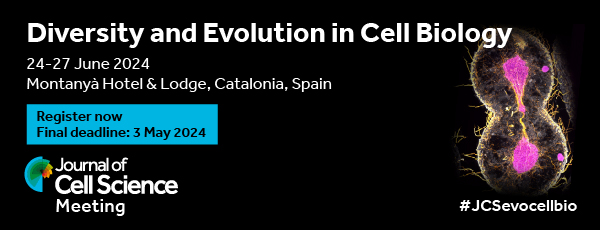Issues
-
Cover image
Cover Image

Cover: Macropinocytosis is an evolutionarily conserved nutrient-scavenging pathway. In Dictyostelium discoideum cells, the proton-coupled oligopeptide transporter Slc15A sustains the macropinocytic activity of cells by maintaining intracellular availability of key amino acids. The time-lapse images show the dynamic distribution of Slc15A–GFP (green) and the PI(3,4)P2 sensor TAPP1–RFP (magenta) during macropinocytosis. See recent article by Y. Zhang, H. Tu et al. (jcs259450).
- PDF Icon PDF LinkTable of contents
- PDF Icon PDF LinkIssue info
RESEARCH HIGHLIGHTS
JCS PRIZE
CELL SCIENTISTS TO WATCH
ESSAYS
REVIEWS
Chaperone-mediated assembly of the proteasome core particle – recent developments and structural insights
Summary: Proteasomes are large multisubunit complexes responsible for destroying proteins. This Review discusses how new proteasomes are assembled.
Looking beyond the gene network – metabolic and mechanical cell drivers of leaf morphogenesis
Summary: A multiscale review on leaf morphogenesis, focusing on coordinated, non-cell-autonomous growth regulations via metabolism and biomechanics.
RESEARCH ARTICLES
Emerin regulation of nuclear stiffness is required for fast amoeboid migration in confined environments
Summary: In mechanically constrictive microenvironments, amoeboid migrating melanoma cells require emerin for the precise calibration of nuclear stiffness.
The yeast LYST homolog Bph1 is a Rab5 effector and prevents Atg8 lipidation at endosomes
Highlighted Article: The yeast LYST homolog Bph1 is an endosomal Rab5 effector that maintains endosomal function. Loss of Bph1 causes defects in endoytosis and Atg8 lipidation at endosomes, suggesting a function in endosomal biogenesis.
Reciprocal regulation of p21 and Chk1 controls the cyclin D1-RB pathway to mediate senescence onset after G2 arrest
Summary: Senescence onset after G2 arrest requires Chk1 downregulation and inhibition of CycD1–CDK RB kinases by p21 and is compromised in cancer cells due to delayed p21 induction and sustained Chk1 activity.
A network of transcription factors governs the dynamics of NODAL/Activin transcriptional responses
Summary: ATAC-seq and footprinting analysis reveals the transcription factor networks underlying NODAL/Activin signalling responses and a self-enabling regulatory mechanism that explains the expression of delayed NODAL/Activin target genes.
PLK1 controls centriole distal appendage formation and centrobin removal via independent pathways
Highlighted Article: During centriole maturation, the concomitant mitotic removal of centrobin and the recruitment of distal appendage proteins in human cells are both independent, yet both depend on the kinase PLK1.
Naphthoquinone-induced arylation inhibits Sirtuin 7 activity
Summary: The catalytic activity of the deacetylase Sirtuin 7 is inhibited in vitro and in vivo by the naphthoquinones menadione and plumbagin in a manner dependent on sulfhydryl arylation reactions.
Expression analysis and function of mitochondrial genome-encoded microRNAs
Summary: Mitochondria genome-encoded miRNAs (mitomiRs) physically interact with the RISC protein Ago2 inside mitochondria and cytoplasm to regulate mitochondrial DNA copy number in breast cancer.
Centrosome maturation requires phosphorylation-mediated sequential domain interactions of SPD-5
Summary: Mitotic PCM scaffold assembly in C. elegans embryos requires sequential domain interactions of SPD-5 mediated by PLK-1 phosphorylation.
MAPK activation drives male and female mouse teratocarcinomas from late primordial germ cells
Summary: The Braf V600E mutation transforms mouse late PGCs of both sexes in teratocarcinomas expressing stemness markers Sox2, Oct4 and Prdm14. Braf V600E ovaries show high numbers of growing and multi-ovular follicles and contain metaphase I oocytes.
TOOLS AND RESOURCES
A point mutation in human coilin prevents Cajal body formation
Summary: We identified a point mutation in human coilin clone deposited in Addgene that prevents Cajal body formation in mouse and human coilin-knockout cells and negatively affects the integrity of Cajal bodies in wild-type cells.
FIRST PERSON
PREPRINT HIGHLIGHTS
Introducing our new Editors

We welcome three new Editors to Journal of Cell Science - Robert Parton, Richa Rikhy and Simon Cook. You can read more about them in the Editorial from our Editor-in-Chief Michael Way.
2024 Journal Meeting 'Diversity and Evolution in Cell Biology'

Registration is open for our 2024 Journal Meeting Diversity and Evolution in Cell Biology, which aims to bring together evolutionary biologists and cell biologists investigating diverse aspects of cellular physiology. Final registration deadline: 3 May 2024.
Workshop: Physics of the Early Embryonic Cell Divisions

Early-career researchers interested in the roles of nuclear lipids, apply now for one of the ten funded places at this Workshop, which will take place 11-14 November 2024. Application deadline: 17 May.
Reasons to submit to Journal of Cell Science

There are many benefits to publishing in Journal of Cell Science - read more about why you should choose JCS or visit our submission page now.
Propose a new Workshop for 2026

We are now accepting proposals for our 2026 Workshops programme. We aim to be responsive to the community and open to novel initiatives, so if you have a new idea for a biological workshop that you feel would work well, please apply. Applications deadline: 19 July 2024.



